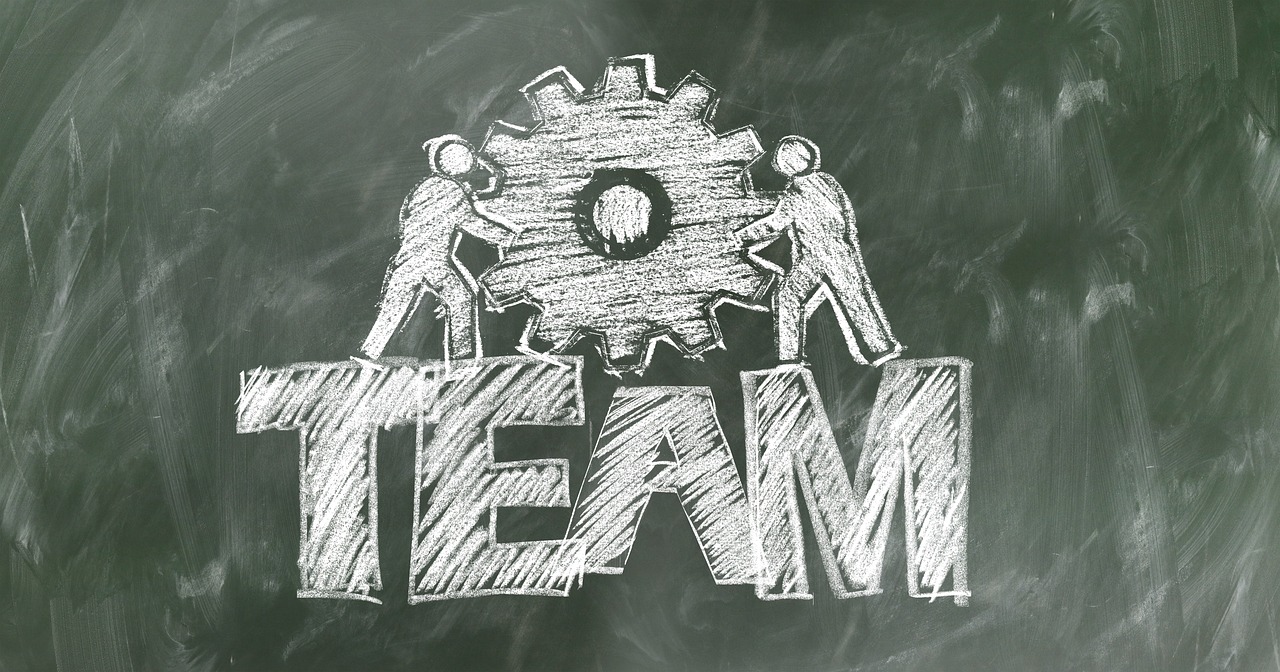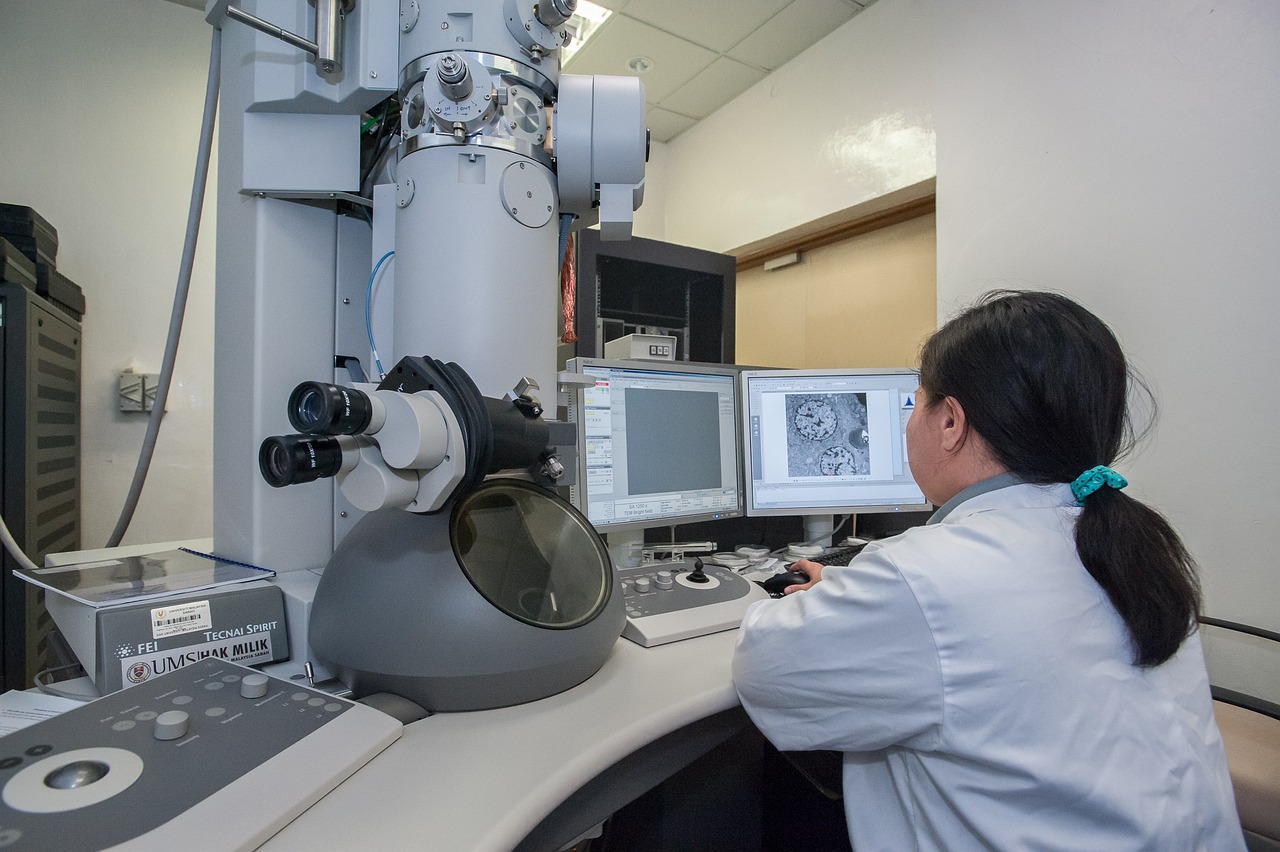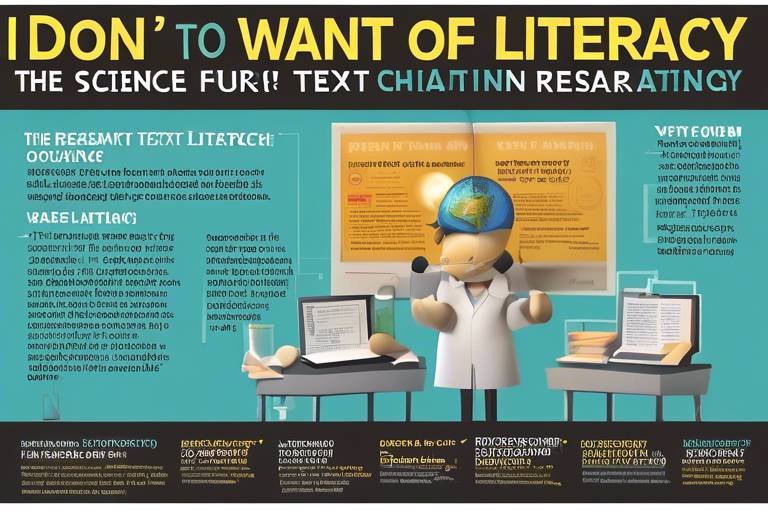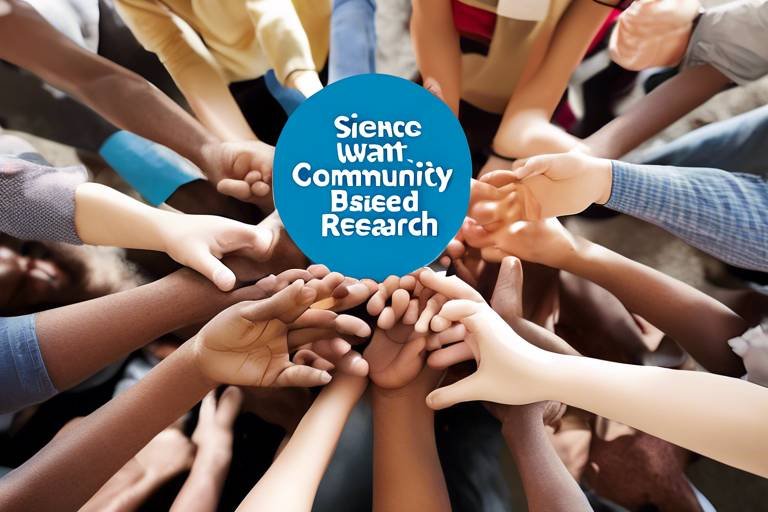How to Foster Innovation in Research Teams
In today's fast-paced world, the ability to innovate is not just a luxury; it's a necessity. Research teams are at the forefront of this innovation, driving discoveries that can change our lives. But how do you cultivate that spark of creativity within these teams? It all starts with fostering an environment where ideas can flourish. This article explores effective strategies to cultivate creativity and innovation within research teams, enhancing collaboration, productivity, and groundbreaking discoveries in various fields.
A collaborative environment is like fertile soil for innovation; it encourages open communication and idea sharing among team members, leading to innovative solutions. To foster collaboration effectively, consider implementing the following techniques:
- Open Communication Channels: Create platforms where team members can freely express their ideas without fear of judgment.
- Regular Brainstorming Sessions: Schedule dedicated time for brainstorming, allowing everyone to contribute their thoughts.
- Team-Building Activities: Engage in activities that strengthen relationships and trust among team members.
When team members feel valued and heard, they are more likely to share unique insights that can lead to groundbreaking innovations.
Diversity in research teams is not just a buzzword; it's a powerful catalyst for creativity. When team members come from varied backgrounds and experiences, they bring unique viewpoints that can enhance problem-solving. This section explores the importance of including diverse perspectives in fostering innovation.
Imagine a team composed of individuals from different fields, such as biology, engineering, and social sciences. This is the essence of a multidisciplinary team. By leveraging expertise from various disciplines, teams can uncover unique insights and innovative approaches that would otherwise remain hidden. For instance, a team working on renewable energy might include environmental scientists, engineers, and economists, each contributing their specialized knowledge to create a more comprehensive solution.
Integrating various skill sets within a team promotes creativity and problem-solving. When team members possess different talents—be it analytical skills, creative thinking, or technical expertise—they can tackle challenges from multiple angles. This not only enhances the team's overall performance but also fosters an environment where innovative ideas can thrive.
Cross-disciplinary collaboration encourages knowledge exchange between fields, sparking innovative ideas. For example, a project that combines computer science with healthcare can lead to the development of groundbreaking medical technologies. Successful examples abound, where teams have bridged gaps between disciplines to achieve remarkable results. Strategies for effective collaboration include:
- Establishing clear communication protocols.
- Creating joint workshops or seminars.
- Encouraging informal meet-ups to discuss ideas.
Creating a safe environment where team members feel comfortable sharing ideas is crucial for innovation. When individuals believe their contributions will be met with respect and consideration, they are more likely to engage in open dialogue and experimentation. Methods to encourage this include regular feedback sessions, anonymous suggestion boxes, and promoting a culture that celebrates risk-taking.
Agile methodologies promote flexibility and adaptability, essential for innovation. By implementing these practices, research teams can enhance their dynamics and responsiveness to change. Agile approaches allow teams to pivot quickly based on feedback and new information, ensuring that they remain on the cutting edge of their fields.
Iterative processes allow teams to refine ideas through continuous feedback. Think of it as sculpting a masterpiece; each iteration brings you closer to the final product. This method not only leads to innovative breakthroughs but also fosters a culture of constant improvement, where every team member feels invested in the outcome.
Rapid prototyping enables quick testing of ideas, facilitating innovation. In research and development, the ability to swiftly create and test prototypes can lead to significant advancements. By embracing rapid iterations, teams can explore multiple avenues and discover what truly works, ultimately accelerating their innovation journey.
Continuous learning is vital for keeping research teams innovative. In a world that is constantly evolving, staying updated with the latest trends and technologies is crucial. Strategies for promoting ongoing education and skill development among team members include:
Workshops and training programs provide valuable opportunities for skill enhancement. These initiatives can cover a wide range of topics, from new research methodologies to emerging technologies. By investing in the continuous education of team members, organizations can ensure that their teams remain at the forefront of innovation.
Knowledge sharing platforms facilitate the exchange of ideas and resources. Implementing effective systems for sharing insights within teams can greatly enhance collaboration and innovation. Consider creating an internal wiki or forum where team members can post articles, share experiences, and discuss new findings.
Measuring innovation outcomes is crucial for assessing the effectiveness of strategies. By tracking progress and success, teams can identify what works and what needs improvement. Key metrics might include the number of new ideas generated, successful project completions, and overall impact on the field.
Defining clear success metrics helps teams understand their innovation impact. These metrics can vary based on the team's objectives but should always align with the overall goals of the organization. Examples include the rate of new patents filed, publications in high-impact journals, or successful product launches.
Implementing feedback loops allows for continuous improvement in innovation processes. Establishing effective feedback mechanisms within research teams ensures that lessons learned from each project are documented and utilized in future endeavors, creating a cycle of growth and enhancement.
Recognizing achievements and learning from setbacks fosters a positive culture of innovation. Celebrating milestones not only boosts morale but also reinforces the behaviors that lead to success. On the flip side, analyzing failures constructively can provide invaluable insights for future projects.
Recognition programs motivate team members by acknowledging their contributions. Implementing such programs can take various forms, from awards to public acknowledgments, and can significantly enhance team spirit and drive.
Post-mortem analyses help teams learn from unsuccessful projects. By conducting constructive reviews, teams can identify what went wrong and develop strategies to avoid similar pitfalls in the future, ultimately enhancing their innovation efforts.
Q1: How can I encourage my team to share their ideas?
A1: Create a safe environment for open communication, hold regular brainstorming sessions, and ensure that all ideas are valued.
Q2: What are some effective ways to build multidisciplinary teams?
A2: Identify individuals from various fields, encourage collaboration through joint projects, and promote a culture of respect for diverse perspectives.
Q3: How do I measure the success of innovation in my team?
A3: Define clear success metrics, track progress through feedback loops, and analyze both successes and failures to understand impact.

Creating a Collaborative Environment
In the fast-paced world of research, fostering a collaborative environment is not just a luxury—it's a necessity. Imagine a space where ideas flow freely, and every voice is valued. This is the essence of collaboration. When team members feel comfortable sharing their thoughts, the potential for innovation skyrockets. To create such an environment, leaders must prioritize open communication, establish trust, and encourage active participation.
One effective technique is to implement regular brainstorming sessions. These gatherings can be informal, allowing team members to express their ideas without the fear of judgment. Picture this: a room filled with passionate individuals bouncing ideas off each other, creating a ripple effect of creativity. To enhance these sessions, consider the following strategies:
- Set Clear Goals: Define the purpose of each brainstorming session to keep discussions focused.
- Encourage All Voices: Ensure that everyone, regardless of their role, has the opportunity to contribute.
- Utilize Technology: Use collaborative tools like digital whiteboards or project management software to capture ideas in real-time.
Another cornerstone of a collaborative environment is trust. When team members trust one another, they are more likely to share their ideas openly. Trust can be built through team-building activities, where individuals get to know each other beyond their professional roles. Activities like workshops or retreats can help break down barriers and foster a sense of camaraderie.
Moreover, recognizing and celebrating team achievements can significantly boost morale and collaboration. Whether it's a successful project completion or a creative breakthrough, acknowledging these moments reinforces the idea that teamwork leads to success. This could be as simple as a shout-out during a meeting or a more formal recognition program.
Finally, it's crucial to create a physical space that encourages collaboration. Open office layouts, comfortable seating areas, and communal spaces can facilitate spontaneous discussions and idea sharing. Think of it as creating a collaboration hub—a place where innovation is not just encouraged but is a natural outcome of the environment.
In conclusion, creating a collaborative environment is about more than just having the right tools or setting up the perfect office space. It requires a commitment to fostering trust, encouraging participation, and celebrating successes. By implementing these strategies, research teams can unlock their full potential and pave the way for groundbreaking discoveries.
Q1: What are the key elements of a collaborative environment?
A1: Key elements include open communication, trust, recognition of contributions, and a conducive physical space.
Q2: How can I encourage quieter team members to share their ideas?
A2: Consider using anonymous suggestion boxes or small group discussions to help them feel more comfortable.
Q3: What role does technology play in fostering collaboration?
A3: Technology facilitates communication and idea sharing, making it easier for teams to collaborate, especially in remote settings.

Encouraging Diverse Perspectives
When it comes to innovation, one of the most powerful tools in a research team's arsenal is diversity. Imagine a vibrant tapestry woven from threads of different colors, textures, and patterns; this is what a diverse team looks like. Each member brings their unique experiences, cultural backgrounds, and perspectives to the table, creating a rich environment where creativity can flourish. By encouraging diverse perspectives, teams can unlock new ideas and approaches that might have otherwise remained hidden.
So, how can we effectively foster this diversity within research teams? First and foremost, it's essential to actively seek out individuals from various backgrounds. This means not just focusing on gender or ethnicity, but also considering factors such as age, education, and professional experiences. When assembling a team, think about how each member's unique viewpoint can contribute to the group's overall goals. For instance, a team composed of members from different scientific disciplines can lead to groundbreaking discoveries that a more homogenous group might overlook.
Furthermore, it's crucial to create an environment where all voices are heard and valued. Encourage team members to share their opinions and ideas, even if they differ from the majority. This can be achieved through structured brainstorming sessions or informal discussions, where everyone is invited to contribute. A great way to facilitate this is by implementing a “no idea is a bad idea” rule, which encourages team members to voice their thoughts without fear of judgment. When individuals feel safe and respected, they are more likely to share their innovative ideas.
Incorporating diverse perspectives can also lead to improved problem-solving. When faced with a challenge, a team with varied backgrounds can approach the issue from multiple angles, leading to more comprehensive solutions. For example, consider a team tasked with developing a new technology. An engineer may focus on the technical aspects, while a marketing expert can provide insights into consumer needs, and a psychologist can shed light on user behavior. Together, they can create a product that not only functions well but also resonates with its intended audience.
To further illustrate the impact of diverse perspectives, let's take a look at a few notable examples:
| Company | Innovation | Diverse Perspective Contribution |
|---|---|---|
| Search Algorithm Updates | Inclusion of linguists and sociologists to enhance search relevance across cultures. | |
| Apple | Product Design | Collaboration between engineers, artists, and usability experts to create user-friendly interfaces. |
| NASA | Space Exploration Technologies | Input from scientists, engineers, and even artists to inspire creative solutions for complex challenges. |
In conclusion, embracing and encouraging diverse perspectives within research teams is not just a nice-to-have; it’s a critical component of innovation. By actively seeking out diverse team members, promoting an inclusive environment, and leveraging the unique strengths of each individual, research teams can enhance their creativity and problem-solving capabilities. This not only leads to more innovative solutions but also fosters a culture of respect and collaboration that can propel the team—and its groundbreaking discoveries—forward.
- Why is diversity important in research teams?
Diversity brings a variety of perspectives and ideas, which can lead to more innovative solutions and improved problem-solving. - How can I encourage my team to share their ideas?
Create a safe space for open dialogue and implement rules that promote idea sharing without fear of judgment. - What are some strategies to build diverse teams?
Actively seek individuals from different backgrounds, experiences, and disciplines during the recruitment process. - Can diversity lead to conflict within teams?
While it can, effective communication and conflict resolution strategies can help turn potential conflicts into opportunities for growth and innovation.

Building Multidisciplinary Teams
Building multidisciplinary teams is like assembling a vibrant puzzle, where each piece represents a unique skill set and perspective. By bringing together individuals from various fields, we not only enhance creativity but also open the door to innovative solutions that may not emerge within a homogeneous group. Imagine a team where scientists, artists, engineers, and social scientists collaborate; the fusion of these diverse backgrounds can lead to groundbreaking discoveries and revolutionary ideas.
One of the key benefits of multidisciplinary teams is the ability to leverage different expertise and insights. For instance, a project focusing on environmental sustainability might benefit from the technical knowledge of an engineer, the creativity of an artist, and the analytical skills of a social scientist. This blend of talents allows teams to approach problems from multiple angles, facilitating a more comprehensive understanding of complex issues.
Moreover, when team members come from various disciplines, they often bring distinct methodologies and frameworks for problem-solving. This diversity can lead to innovative approaches that challenge traditional thinking. For example, in a healthcare research team, incorporating perspectives from psychology, data science, and public health can result in more effective interventions and programs. The cross-pollination of ideas not only fosters creativity but also encourages team members to step out of their comfort zones, embracing new ways of thinking.
To effectively build these multidisciplinary teams, organizations should consider the following strategies:
- Identify Complementary Skills: Assess the skills needed for a project and seek individuals whose expertise complements one another.
- Encourage Open Communication: Create an environment where team members feel comfortable sharing their thoughts and ideas, regardless of their background.
- Facilitate Team-Building Activities: Engage in exercises that promote collaboration and understanding among team members from different fields.
Furthermore, it is essential to establish a clear vision and common goals for the team. When everyone understands the objectives, it aligns their diverse skills toward a unified purpose, enhancing collaboration and productivity. Regular check-ins and feedback sessions can also help maintain this alignment, ensuring that all voices are heard and valued.
In conclusion, building multidisciplinary teams is not just about mixing different professionals; it's about creating a dynamic environment where innovation can thrive. By embracing diversity in skills and perspectives, organizations can unlock a treasure trove of creativity, leading to impactful solutions that can change the world.
Q: What are the main benefits of multidisciplinary teams?
A: The primary benefits include enhanced creativity, diverse problem-solving approaches, and a comprehensive understanding of complex issues, leading to innovative solutions.
Q: How can organizations effectively build multidisciplinary teams?
A: Organizations can build these teams by identifying complementary skills, encouraging open communication, and facilitating team-building activities to promote collaboration.
Q: What role does communication play in multidisciplinary teams?
A: Open communication is crucial as it fosters an environment where team members feel comfortable sharing ideas, which is essential for innovation and effective collaboration.

Integrating Different Skill Sets
Integrating different skill sets within a research team is like assembling a jigsaw puzzle; each piece is unique, but together they create a complete picture. When team members bring varied expertise to the table, the potential for creativity and innovation skyrockets. Imagine a scenario where a biologist collaborates with a data scientist. The biologist understands the nuances of living organisms, while the data scientist excels in analyzing complex datasets. Together, they can uncover insights that neither could achieve alone. This synergy is what makes integrating diverse skill sets essential for any research initiative.
To effectively combine these talents, it's crucial to establish a culture that values each member's contributions. This can be achieved by fostering open communication channels where team members can share their knowledge freely. Regular brainstorming sessions can serve as a platform for idea generation, allowing individuals to showcase their unique perspectives. Additionally, utilizing tools that facilitate collaboration, such as project management software or shared digital workspaces, can enhance teamwork and streamline the integration process.
Moreover, it's important to recognize that integrating different skill sets goes beyond mere collaboration. It requires an understanding of how each skill can complement others. For instance, a team composed of individuals with backgrounds in engineering, psychology, and marketing can tackle a project from multiple angles, leading to more holistic solutions. This multidisciplinary approach not only broadens the team's capabilities but also enhances problem-solving skills.
In practice, this integration can be structured through cross-functional teams. These teams are designed to include members from various departments or specialties, ensuring that every project benefits from a wide range of expertise. For example, a research team aiming to develop a new healthcare product might include clinicians, engineers, and regulatory experts. By bringing together these different skill sets, the team can navigate the complexities of product development more effectively, ensuring that the final outcome is not only innovative but also practical and compliant with industry standards.
Ultimately, the key to successfully integrating different skill sets lies in creating an environment where collaboration is not just encouraged but celebrated. This means recognizing and rewarding innovative contributions, which can further motivate team members to leverage their unique skills for the collective good. When individuals feel valued for their expertise, they are more likely to engage actively in the innovation process, leading to groundbreaking discoveries and advancements in research.
- What are the benefits of integrating different skill sets in research teams?
Integrating different skill sets enhances creativity, fosters innovative solutions, and allows for a more comprehensive approach to problem-solving. - How can teams encourage collaboration among members with diverse skills?
Teams can encourage collaboration by fostering open communication, conducting regular brainstorming sessions, and utilizing collaborative tools and platforms. - What is a cross-functional team?
A cross-functional team is composed of members from various departments or specialties, allowing for a multidisciplinary approach to projects. - How can recognition of contributions enhance team dynamics?
Recognizing contributions motivates team members, encourages active participation, and creates a positive culture that values innovation.

Cross-Disciplinary Collaboration
In today's fast-paced research landscape, has emerged as a vital catalyst for innovation. When experts from various fields come together, they bring a wealth of knowledge, unique perspectives, and diverse problem-solving approaches that can lead to groundbreaking discoveries. Imagine a team comprised of biologists, engineers, and data scientists all working together; the fusion of their skills can ignite creativity in ways that a single discipline might struggle to achieve. This collaborative synergy is not just beneficial; it’s essential for tackling complex challenges that require multifaceted solutions.
One of the most significant advantages of cross-disciplinary collaboration is the ability to spark innovative ideas. When team members share their distinct viewpoints, they can challenge each other's assumptions and push the boundaries of conventional thinking. This environment encourages experimentation and the exploration of uncharted territories, leading to solutions that are not only novel but also practical. For instance, a project that involves environmental science and technology can yield innovative approaches to sustainability that neither field could accomplish alone.
To maximize the benefits of cross-disciplinary collaboration, it’s crucial to establish an environment that fosters open communication and trust. Team members should feel comfortable sharing their ideas, no matter how unconventional they may seem. Regular brainstorming sessions, where all voices are heard, can be instrumental in creating this atmosphere. Moreover, utilizing collaborative tools and platforms can facilitate seamless interaction and idea exchange, ensuring that everyone is on the same page and contributing to the collective goal.
However, collaborating across disciplines isn’t without its challenges. Differences in terminology, methodologies, and even work cultures can lead to misunderstandings and friction among team members. To mitigate these issues, it’s important to invest time in building a common language and understanding the strengths and weaknesses of each discipline involved. Workshops and team-building activities can be effective in bridging these gaps, allowing team members to appreciate each other’s expertise and work styles.
In conclusion, cross-disciplinary collaboration is not merely a trend; it’s a powerful strategy for driving innovation in research. By embracing diverse perspectives and fostering an environment of open communication, teams can unlock new pathways to discovery and create solutions that have a lasting impact on society. As we continue to face increasingly complex global challenges, the ability to collaborate across disciplines will be more important than ever.
- What is cross-disciplinary collaboration?
Cross-disciplinary collaboration involves bringing together experts from different fields to work on a common project, leveraging their diverse skills and perspectives for innovative solutions.
- Why is cross-disciplinary collaboration important?
It enhances creativity, encourages problem-solving from multiple angles, and leads to groundbreaking discoveries that a single discipline may not achieve alone.
- How can teams foster a collaborative environment?
Teams can foster collaboration by promoting open communication, establishing trust, and utilizing collaborative tools and platforms.
- What are some challenges of cross-disciplinary collaboration?
Challenges include differences in terminology, methodologies, and work cultures, which can lead to misunderstandings. Addressing these through workshops and team-building activities is essential.

Fostering a Safe Space for Ideas
Creating a safe space for ideas is essential for any research team aiming to innovate and push boundaries. Imagine a garden where every flower, no matter how unusual, is nurtured to bloom. In the same way, a safe environment allows team members to express their thoughts without the fear of judgment. This fosters a culture of open dialogue and experimentation, which is crucial for groundbreaking discoveries. When individuals feel secure in sharing their ideas, even the most unconventional thoughts can lead to revolutionary breakthroughs.
To cultivate this safe space, team leaders must prioritize emotional safety. This involves actively listening to team members and valuing their input, regardless of how far-fetched it may seem. Encouraging a culture where every voice matters can significantly enhance creativity. For instance, regular brainstorming sessions can be structured in a way that emphasizes the importance of all contributions, allowing everyone to feel like a vital part of the team.
Moreover, establishing ground rules for discussions can help maintain a respectful and supportive atmosphere. Here are some effective guidelines to consider:
- Encourage constructive feedback rather than criticism.
- Promote the idea that all suggestions are valuable, even if they aren't feasible.
- Foster an environment where team members can share failures as learning experiences.
Additionally, incorporating team-building activities can help build trust among members. When people feel connected on a personal level, they are more likely to share their ideas freely. Activities that encourage collaboration and communication can break down barriers and pave the way for more innovative thinking.
In conclusion, fostering a safe space for ideas is not just about creating a comfortable environment; it's about cultivating a culture of innovation. When team members feel secure in sharing their thoughts, they are more likely to contribute to the collective creativity of the group. This ultimately leads to enhanced collaboration, productivity, and, most importantly, groundbreaking discoveries that can change the world.
- What is a safe space for ideas? A safe space for ideas is an environment where team members feel comfortable sharing their thoughts without fear of judgment or criticism.
- How can I foster a safe space in my team? You can foster a safe space by encouraging open dialogue, establishing ground rules, and promoting team-building activities.
- Why is emotional safety important in a research team? Emotional safety is crucial because it allows individuals to express unconventional ideas, leading to greater creativity and innovation.

Implementing Agile Methodologies
In the fast-paced world of research, agility is more than just a buzzword; it's a necessity. Implementing agile methodologies can significantly enhance the dynamics of research teams, allowing them to adapt quickly to changes and challenges. Think of agile as a flexible framework that enables teams to pivot and iterate based on real-time feedback, much like a skilled dancer who adjusts their movements to the rhythm of the music. This section delves into how these methodologies can revolutionize your team's approach to innovation.
At its core, agile methodologies emphasize collaboration and continuous improvement. By breaking down projects into smaller, manageable chunks, teams can focus on delivering value incrementally. This approach not only boosts morale but also enhances productivity, as team members can see the tangible results of their efforts more frequently. Imagine a relay race where each runner passes the baton smoothly, ensuring that the team stays on track and maintains momentum. Agile practices encourage this kind of seamless collaboration.
One of the most impactful aspects of agile is the concept of iterative processes. Instead of waiting until the end of a lengthy research cycle to assess outcomes, teams can continuously refine their ideas through regular feedback. This iterative approach allows for early detection of potential issues and enables teams to pivot quickly if needed. For instance, a research team working on a new drug might conduct small trials, gather data, and adjust their methods based on initial results—effectively ensuring that they are always moving in the right direction.
Another key component of agile methodologies is rapid prototyping. This technique allows teams to create quick models of their ideas, facilitating swift testing and validation. In research, where time and resources are often limited, the ability to test concepts rapidly can lead to groundbreaking discoveries. Picture this: a team develops a prototype device that can monitor environmental changes. By testing it in real-time, they can gather invaluable data that informs further development and innovation.
To implement agile methodologies effectively, it's essential to foster a culture that embraces flexibility and open communication. Team members should feel empowered to share their ideas and feedback without fear of judgment. This can be achieved by holding regular stand-up meetings, where everyone has the opportunity to voice their thoughts and progress. Additionally, utilizing visual management tools like Kanban boards can help teams track their tasks and progress in a transparent manner, ensuring that everyone is on the same page.
In conclusion, adopting agile methodologies can dramatically enhance the effectiveness of research teams. By promoting iterative processes and rapid prototyping, teams can not only improve their output but also foster a culture of innovation that drives groundbreaking discoveries. Embracing these practices is like giving your team a turbo boost, propelling them toward success in an ever-evolving landscape.
- What are agile methodologies?
Agile methodologies are frameworks that promote flexibility, collaboration, and iterative progress in project management, allowing teams to adapt quickly to changes. - How can agile methodologies benefit research teams?
By implementing agile practices, research teams can enhance productivity, foster innovation, and improve collaboration among members. - What is rapid prototyping?
Rapid prototyping is the process of quickly creating a model of an idea to test and validate it, facilitating faster innovation. - How can I encourage a culture of agility in my team?
Encourage open communication, conduct regular feedback sessions, and utilize visual management tools to promote a transparent and flexible work environment.

Iterative Processes
When it comes to fostering innovation within research teams, play a pivotal role. Think of it like sculpting a masterpiece from a block of marble; you chip away at it gradually, refining your creation with each stroke. This method allows teams to continuously refine their ideas through feedback loops and adjustments, transforming initial concepts into groundbreaking solutions. By embracing an iterative approach, research teams can adapt to new information and insights, ensuring that their work remains relevant and impactful.
One of the most significant advantages of iterative processes is the ability to identify and address potential issues early in the development cycle. Instead of waiting until a project is fully developed to unveil it, teams can share prototypes or drafts at various stages. This practice not only promotes collaboration but also invites constructive criticism, which can lead to innovative breakthroughs. For instance, when a research team is working on a new drug, they might conduct several rounds of testing and analysis, each time refining their formula based on results and expert feedback.
To implement effective iterative processes, consider the following key steps:
- Define Clear Goals: Establish what you want to achieve at each iteration. This clarity helps focus the team's efforts and measure progress.
- Gather Feedback: After each iteration, collect insights from stakeholders, team members, and potential users. This feedback is invaluable for making informed adjustments.
- Make Adjustments: Use the feedback to refine your project. This could mean altering your approach, changing a design element, or even pivoting to a new idea altogether.
- Repeat the Process: Continue iterating until you reach a solution that meets the project goals and satisfies user needs. Each cycle should bring you closer to the desired outcome.
Moreover, the iterative process is not just about refining the product; it also enhances team dynamics. As members engage in this cyclical feedback system, they become more aligned with each other's perspectives, leading to a more cohesive unit. The collaborative spirit fostered through iterations can ignite creativity and motivate team members to contribute their best ideas, knowing that their input is valued and impactful.
In summary, embracing iterative processes within research teams is not merely a strategy; it is a catalyst for innovation. By continuously refining ideas, gathering feedback, and making necessary adjustments, teams can navigate the complexities of research and development with agility and creativity. This approach not only leads to better outcomes but also cultivates a culture of collaboration and open-mindedness, essential for groundbreaking discoveries.
- What are iterative processes? Iterative processes involve repeated cycles of development, allowing teams to refine their ideas and solutions based on continuous feedback.
- Why are iterative processes important for research teams? They enable teams to address issues early, adapt to new information, and foster collaboration, leading to innovative outcomes.
- How can teams effectively implement iterative processes? By defining clear goals, gathering feedback, making adjustments, and repeating the process until the desired outcome is achieved.
- What role does feedback play in iterative processes? Feedback is crucial as it guides the refinement of ideas and helps teams make informed decisions about their projects.

Rapid Prototyping
In the fast-paced world of research and development, has emerged as a game-changer, enabling teams to transform ideas into tangible products quickly and efficiently. Imagine trying to build a house without a blueprint; you'd likely end up with something that doesn't quite meet your needs. Rapid prototyping serves as that essential blueprint, allowing teams to visualize their concepts, iterate on designs, and make improvements before committing to a full-scale project.
This method not only accelerates the development process but also significantly reduces the risk of failure. By testing ideas early and often, research teams can identify potential flaws and areas for enhancement long before they hit the market. The result? A more refined final product that resonates with users and stands out in a competitive landscape.
One of the key aspects of rapid prototyping is its iterative nature. Teams can create multiple versions of a product, each incorporating feedback from previous iterations. This cycle of design, test, and refine ensures that the final output is not just a shot in the dark but a well-informed solution tailored to meet user needs. For instance, a research team working on a new medical device can prototype different designs, test them with healthcare professionals, and adjust features based on real-world feedback. This approach leads to innovations that are not only functional but also user-friendly.
Moreover, the tools available for rapid prototyping have evolved dramatically in recent years. From 3D printing to software simulations, teams now have access to a variety of technologies that can bring their ideas to life in a matter of days or even hours. These tools allow for quick adjustments and modifications, making it easier than ever to pivot when necessary. For example, a team developing a new app can create a basic version, gather user feedback, and make changes on the fly, ensuring that they are on the right track before investing significant time and resources.
To illustrate the impact of rapid prototyping, consider the following table that outlines its benefits:
| Benefit | Description |
|---|---|
| Speed | Accelerates the development process, allowing for quicker market entry. |
| Cost-Effectiveness | Reduces the risk of costly mistakes by identifying issues early. |
| User-Centric Design | Incorporates user feedback into the design process, leading to better products. |
| Innovation | Encourages creative thinking and exploration of new ideas. |
In conclusion, rapid prototyping is not just a trend; it's a vital strategy for research teams aiming to foster innovation. By embracing this approach, teams can enhance their creativity, streamline their processes, and ultimately deliver products that meet the ever-evolving demands of their users. So, if you're looking to spark innovation within your research team, consider implementing rapid prototyping as a core component of your development strategy.
- What is rapid prototyping? Rapid prototyping is a method used to quickly create a scale model of a physical part or assembly using 3D computer-aided design (CAD) data.
- How does rapid prototyping benefit research teams? It allows teams to test ideas quickly, reduce costs by identifying issues early, and incorporate user feedback into the design process.
- What technologies are used in rapid prototyping? Common technologies include 3D printing, CNC machining, and software simulations.
- Can rapid prototyping be used in all industries? Yes, rapid prototyping can be applied in various fields, including healthcare, engineering, and consumer products.

Encouraging Continuous Learning
In the fast-paced world of research, continuous learning isn't just a nice-to-have; it's a necessity. As new technologies and methodologies emerge, keeping the knowledge reservoir full is essential for any research team aiming to stay ahead of the curve. But how do we cultivate a culture where learning is not only encouraged but celebrated? It starts with a mindset shift—viewing learning as an ongoing journey rather than a destination. When team members see themselves as lifelong learners, they become more engaged, innovative, and resilient.
One effective way to promote continuous learning is through workshops and training programs. These can be tailored to meet the specific needs of the team and can cover a variety of topics—from the latest research techniques to soft skills like communication and teamwork. Imagine a monthly workshop where team members can dive deep into a subject, share insights, and apply new skills in real-time. Such initiatives not only enhance individual capabilities but also strengthen team cohesion.
Another powerful tool is the implementation of knowledge sharing platforms. These platforms serve as a central hub for resources, articles, and best practices. Think of it as a digital library where team members can contribute and access valuable information at any time. By encouraging everyone to share their findings, whether it’s a groundbreaking article or a simple tip that made their work easier, teams can benefit from a collective intelligence that fuels innovation. Here’s a simple structure that can be used to categorize shared knowledge:
| Category | Description | Owner |
|---|---|---|
| Research Techniques | Latest methodologies and tools in the field. | Team Lead |
| Case Studies | Examples of successful projects and lessons learned. | Team Members |
| Soft Skills | Communication, teamwork, and leadership resources. | HR Department |
Additionally, fostering a culture of mentorship can significantly enhance continuous learning. Pairing less experienced team members with seasoned professionals creates an environment where knowledge flows freely. This not only accelerates the learning curve for newcomers but also reinforces the expertise of mentors. It’s like having a personal coach guiding you through the complexities of research, making the journey less daunting and more enriching.
Lastly, it’s crucial to regularly evaluate and adapt these learning initiatives. Feedback loops—where team members can voice their opinions on what’s working and what’s not—are invaluable. This could be as simple as a monthly survey or a dedicated discussion during team meetings. By actively seeking input, teams can refine their learning strategies, ensuring they remain relevant and effective. In the end, a commitment to continuous learning transforms a research team from a group of individuals into a dynamic, innovative powerhouse.
- Why is continuous learning important in research?
Continuous learning helps teams stay updated with the latest trends and methodologies, enhancing their ability to innovate and solve complex problems. - How can I encourage my team to participate in training programs?
Highlight the benefits of these programs and how they can directly impact their work. Additionally, consider offering incentives for participation. - What are some effective knowledge sharing platforms?
Platforms like Confluence, SharePoint, or even Google Drive can be used to facilitate knowledge sharing among team members.

Workshops and Training Programs
Workshops and training programs are not just a box to check on a corporate agenda; they are vital lifelines for innovation within research teams. Imagine a world where every team member is equipped with the latest skills and knowledge, ready to tackle challenges head-on. This is the power of continuous learning! By investing in workshops, organizations create an environment that fosters creativity and problem-solving. These sessions can cover a range of topics, from technical skills to soft skills like communication and teamwork.
One effective approach to structuring these workshops is to tailor them to the specific needs of the team. For instance, if a research team is delving into artificial intelligence, a workshop on the latest AI tools and techniques would be invaluable. Alternatively, if the team struggles with collaboration, a session focused on team dynamics and conflict resolution can work wonders. The key is to ensure that the content is relevant and engaging, sparking interest and participation from all members.
Moreover, the format of these workshops can greatly influence their effectiveness. Hands-on activities, group discussions, and real-life case studies can make the learning experience more impactful. Here’s a simple breakdown of some popular workshop formats:
| Workshop Format | Description |
|---|---|
| Hands-on Workshops | Participants engage in practical exercises that apply the concepts learned. |
| Group Discussions | Facilitated discussions that encourage sharing of ideas and perspectives. |
| Case Studies | Analysis of real-world scenarios to understand best practices and lessons learned. |
Additionally, it’s essential to incorporate follow-up sessions to reinforce learning and address any lingering questions. This could be in the form of refresher courses or even informal meet-ups where team members can share how they’ve applied what they learned. The more opportunities there are for team members to engage with the material, the better they will retain and utilize their new skills.
Another important aspect is to encourage team members to take ownership of their learning journey. This can be achieved by allowing them to suggest topics for workshops or even lead sessions themselves. Empowering individuals to share their expertise not only enhances the learning experience but also builds confidence and fosters a sense of community within the team.
In conclusion, workshops and training programs are not just about acquiring new knowledge; they are about creating a culture of innovation and continuous improvement. By investing in the development of your research team, you are not only enhancing their skills but also paving the way for groundbreaking discoveries that can change the world.
- What types of workshops are most effective for research teams? Hands-on workshops, group discussions, and case studies are particularly effective as they engage participants actively.
- How often should workshops be conducted? Regular workshops, perhaps quarterly or bi-annually, can help keep skills fresh and relevant.
- Can team members lead workshops? Absolutely! Encouraging team members to lead sessions can foster ownership and deepen their understanding.

Knowledge Sharing Platforms
In the fast-paced world of research, having effective is like having a secret weapon. These platforms not only facilitate the exchange of ideas but also act as a catalyst for innovation. Imagine a bustling marketplace where researchers come together to trade their insights, experiences, and discoveries. This vibrant exchange can lead to groundbreaking ideas that might never have surfaced in isolation.
So, what exactly makes these platforms so essential? First and foremost, they create a centralized hub where team members can access valuable resources, share findings, and collaborate on projects. This is particularly important in research environments where information can often be siloed. By breaking down these barriers, teams can harness the collective knowledge of their members, leading to enhanced creativity and productivity.
There are various types of knowledge sharing platforms that organizations can implement, and each serves a unique purpose. For instance, consider the following:
- Intranet Portals: These are internal websites that serve as a repository for documents, research papers, and project updates. They foster collaboration by allowing team members to comment on and discuss shared content.
- Collaboration Tools: Platforms like Slack or Microsoft Teams enable real-time communication and file sharing, making it easier for researchers to engage in discussions and brainstorm ideas.
- Wikis and Knowledge Bases: These allow team members to create and edit content collaboratively, ensuring that knowledge is continuously updated and easily accessible.
Implementing these platforms isn’t just about technology; it’s about cultivating a culture of sharing. Encouraging team members to actively participate and contribute can lead to a more engaged and innovative team. For example, setting aside regular time for knowledge sharing sessions can create a rhythm where ideas flow freely. This could be in the form of lunch-and-learns or dedicated brainstorming meetings.
Moreover, the effectiveness of knowledge sharing platforms can be significantly enhanced by integrating them with other tools and processes. For instance, linking collaboration tools with project management software can streamline workflows and ensure that everyone is on the same page. This integration helps in tracking progress and ensuring that valuable insights are not lost in the shuffle.
To truly leverage the power of knowledge sharing platforms, organizations should also focus on training and onboarding. Ensuring that all team members are familiar with how to use these platforms effectively can make a world of difference. A well-informed team is more likely to engage with the platform and utilize it to its full potential.
In conclusion, knowledge sharing platforms are not just a nice-to-have; they are a necessity for fostering innovation within research teams. By creating an environment where information flows freely and collaboration is encouraged, organizations can unlock the full potential of their teams. After all, in the realm of research, the best ideas often come from the most unexpected places, and a robust knowledge sharing platform can be the bridge that connects them.
- What are knowledge sharing platforms?
Knowledge sharing platforms are tools or systems designed to facilitate the exchange of information, ideas, and resources among team members.
- How can we encourage participation in these platforms?
Encouraging participation can be achieved through regular training, creating a culture of sharing, and providing incentives for contributions.
- What types of platforms are most effective?
The effectiveness of a platform often depends on the team's needs. Common types include intranet portals, collaboration tools, and wikis.
- How do we measure the impact of knowledge sharing?
Impact can be measured through metrics such as increased collaboration, the number of contributions made, and the quality of ideas generated.

Measuring Innovation Outcomes
Measuring innovation outcomes is crucial for assessing the effectiveness of strategies employed within research teams. Just like a gardener checks the health of their plants, teams must evaluate their innovations to understand what works and what needs nurturing. This assessment not only highlights successful initiatives but also identifies areas for improvement, allowing teams to adapt and thrive in a constantly evolving landscape.
To effectively measure innovation outcomes, it's essential to define clear success metrics. These metrics serve as a roadmap, guiding teams in their innovation journey. They can include various indicators such as:
- Number of New Ideas Generated: Tracking the quantity of ideas can provide insight into the team's creative output.
- Implementation Rate: Measuring how many of those ideas are actually put into practice reveals the team's ability to transform concepts into reality.
- Impact on Performance: Evaluating how innovations affect overall performance metrics, such as productivity or revenue, helps gauge their effectiveness.
- Employee Engagement: Monitoring team morale and engagement levels can indicate how well the innovation process resonates with team members.
Once these metrics are defined, it’s important to establish feedback loops for continuous improvement. Feedback loops act like a compass, helping teams navigate their innovation strategies by providing insights into what is working and what isn’t. Regularly scheduled reviews and retrospective meetings can facilitate these feedback loops, where team members can share their experiences and insights about the innovation process. This dialogue not only fosters a culture of transparency but also encourages a mindset of learning and adaptation.
To further enhance the measurement of innovation outcomes, teams can utilize a dashboard that visually represents key performance indicators (KPIs). This dashboard can include metrics such as:
| Metric | Definition | Frequency of Measurement |
|---|---|---|
| New Ideas Generated | Total number of new ideas proposed | Monthly |
| Implementation Rate | Percentage of ideas put into practice | Quarterly |
| Impact on Performance | Change in performance metrics post-implementation | Bi-Annually |
| Employee Engagement | Level of team morale and participation in innovation efforts | Annually |
By regularly reviewing these metrics, teams can make informed decisions about their innovation strategies. It’s like adjusting a recipe based on taste; if something isn’t quite right, tweaking the ingredients can lead to a better dish. Ultimately, measuring innovation outcomes is not just about tracking success; it's about creating a dynamic environment where continuous improvement is part of the culture.
Q: Why is measuring innovation outcomes important?
A: Measuring innovation outcomes is vital because it helps teams understand the effectiveness of their strategies, identify areas for improvement, and foster a culture of continuous learning.
Q: What are some common metrics used to measure innovation?
A: Common metrics include the number of new ideas generated, the implementation rate, impact on performance, and employee engagement levels.
Q: How can feedback loops improve innovation processes?
A: Feedback loops facilitate open communication among team members, allowing them to share insights and experiences, which leads to continuous improvement in innovation strategies.
Q: What role does a dashboard play in measuring innovation?
A: A dashboard visually represents key performance indicators, making it easier for teams to track their innovation metrics and make data-driven decisions.

Defining Success Metrics
When it comes to fostering innovation within research teams, one of the most critical aspects is . These metrics serve as a roadmap, guiding teams towards their goals while providing a tangible way to measure progress. Imagine trying to navigate through a dense forest without a map; it would be incredibly challenging to find your way. Similarly, without clear success metrics, teams may struggle to identify whether their innovative efforts are yielding the desired results.
Success metrics can vary widely depending on the specific goals of a project or the overall objectives of the research team. However, some common types of metrics that can be employed include:
- Output Metrics: These focus on the quantity of ideas generated, prototypes developed, or papers published. They help teams assess how much innovation is being produced.
- Outcome Metrics: These measure the impact of the innovations, such as improvements in efficiency, cost savings, or increased user satisfaction.
- Process Metrics: These evaluate how effectively the innovation process is being executed, including the time taken to move from concept to execution.
To effectively define these metrics, teams should engage in a collaborative discussion to ensure that everyone is on the same page. This can be likened to a sports team huddling together before a big game; everyone must understand their roles and the game plan to achieve victory. During these discussions, consider the following:
| Type of Metric | Purpose | Example |
|---|---|---|
| Output Metrics | Measure the volume of innovations | Number of prototypes created |
| Outcome Metrics | Assess the effectiveness of innovations | Customer satisfaction ratings |
| Process Metrics | Evaluate the efficiency of the innovation process | Time taken to develop a prototype |
Moreover, it’s essential to align these metrics with the overall strategic goals of the organization. This alignment ensures that the efforts of the research team contribute directly to the broader objectives, much like how each player’s performance contributes to the team's success in a game. Regularly reviewing these metrics allows teams to pivot strategies when necessary, ensuring they remain on the path to innovation.
In conclusion, defining success metrics is not just a bureaucratic exercise; it's a vital component of fostering innovation. By clearly establishing what success looks like, research teams can stay focused, motivated, and ultimately more successful in their innovative endeavors.
1. Why are success metrics important for research teams?
Success metrics provide a clear framework for evaluating the effectiveness of innovation efforts, helping teams stay focused and aligned with organizational goals.
2. How often should success metrics be reviewed?
Success metrics should be reviewed regularly, ideally at the end of each project phase or quarterly, to ensure that the team can adapt to any necessary changes.
3. Can success metrics vary between projects?
Absolutely! Success metrics should be tailored to fit the specific goals and objectives of each project, ensuring that they are relevant and meaningful.

Feedback Loops for Improvement
In the dynamic world of research, establishing effective feedback loops is essential for continuous improvement and innovation. Think of feedback loops as the heartbeat of a research team; they keep the team alive and thriving by ensuring that every member's voice is heard and valued. When teams engage in regular feedback sessions, they create a culture where ideas can be refined, and processes can be optimized, leading to groundbreaking discoveries.
Feedback loops serve multiple purposes. They not only provide insights into what is working well but also highlight areas that need improvement. This dual function is crucial because it allows teams to pivot and adapt quickly in response to challenges. For instance, if a particular approach isn't yielding the desired results, feedback can help identify the issue and brainstorm alternative solutions. By fostering an environment where constructive criticism is welcomed, teams can enhance their problem-solving capabilities.
To implement effective feedback loops, consider the following strategies:
- Regular Check-Ins: Schedule consistent meetings to discuss progress and challenges. This creates a routine where team members feel comfortable sharing their thoughts.
- Anonymous Surveys: Sometimes, team members may feel hesitant to voice their opinions openly. Anonymous surveys can encourage honest feedback without fear of repercussions.
- Actionable Insights: Ensure that feedback is not just collected but also acted upon. This demonstrates to team members that their input is valued and leads to tangible improvements.
Moreover, incorporating technology can significantly enhance the feedback process. Tools like project management software and communication platforms can streamline feedback collection and analysis, making it easier for teams to visualize their progress and areas for improvement. For example, using a project management tool that tracks tasks and deadlines can help teams quickly identify bottlenecks and address them before they escalate.
Ultimately, the goal of feedback loops is to create a collaborative ecosystem where innovation can flourish. By continuously refining processes and embracing a mindset of growth, research teams can not only improve their current projects but also lay the groundwork for future success. So, the next time your team embarks on a new project, remember to prioritize feedback loops; they might just be the secret ingredient to unlocking your team's full potential.
- What are feedback loops? Feedback loops are processes that allow teams to collect, analyze, and act upon feedback to improve their work continuously.
- Why are feedback loops important in research? They help teams identify strengths and weaknesses, enabling them to adapt and enhance their strategies for better results.
- How can we encourage team members to provide feedback? Create a safe and open environment, use anonymous surveys, and demonstrate that feedback leads to real change.

Celebrating Successes and Learning from Failures
In the realm of research and innovation, the journey is often just as important as the destination. Celebrating successes is not merely a feel-good exercise; it serves as a powerful catalyst for motivation and morale within research teams. When team members feel recognized for their contributions, it fosters a sense of belonging and encourages them to push the boundaries of creativity. For instance, consider a team that successfully develops a groundbreaking technology. By taking the time to celebrate this achievement—whether through a team lunch, acknowledgment in a company-wide meeting, or a feature in a newsletter—the team members feel valued, which can significantly enhance their engagement and productivity in future projects.
On the flip side, learning from failures is equally crucial. In the world of research, not every idea will hit the mark, and that’s perfectly okay. In fact, some of the greatest innovations have emerged from the ashes of failure. It’s essential to create an environment where setbacks are viewed as opportunities for growth rather than reasons for punishment. By conducting post-mortem analyses, teams can dissect what went wrong, understand the underlying issues, and apply those lessons to future projects. This not only prevents the same mistakes from happening again but also cultivates a culture of resilience and continuous improvement.
To effectively celebrate successes and learn from failures, consider implementing structured recognition programs and constructive review processes. Here’s how you can do it:
- Recognition Programs: Create a system that rewards team members for their contributions, whether big or small. This could be as simple as a "Team Member of the Month" award or as elaborate as an annual gala recognizing outstanding achievements.
- Post-Mortem Analyses: After completing a project, hold a meeting to discuss what went well and what didn’t. Encourage open dialogue and ensure that all team members feel safe to share their thoughts.
By integrating these practices into your research team's culture, you not only enhance morale but also drive innovation forward. Remember, every success is a stepping stone, and every failure is a lesson waiting to be learned. The key is to embrace both with open arms and a positive mindset, allowing your team to thrive in an environment where creativity and collaboration flourish.
Q: Why is it important to celebrate successes in research teams?
A: Celebrating successes boosts morale, fosters a sense of belonging, and motivates team members to continue innovating and collaborating effectively.
Q: How can teams learn from failures without discouraging members?
A: By creating a safe environment for open discussions and conducting constructive post-mortem analyses, teams can analyze failures as learning opportunities rather than setbacks.
Q: What are effective ways to implement recognition programs?
A: Recognition programs can include awards, public acknowledgments, or team-building activities that highlight individual and team contributions.
Q: How often should teams conduct post-mortem analyses?
A: It is beneficial to conduct post-mortem analyses after every significant project or milestone to continuously learn and improve processes.

Recognition Programs
In the fast-paced world of research, where innovative ideas are the lifeblood of progress, play a pivotal role in motivating team members. When researchers feel valued for their contributions, it not only boosts their morale but also enhances their productivity. Imagine a garden where every flower is nurtured; similarly, a well-implemented recognition program can cultivate a thriving environment where creativity blooms.
Recognition can take various forms, from simple verbal acknowledgments during team meetings to more structured programs that reward exceptional contributions. For instance, establishing a "Researcher of the Month" award can provide a tangible goal for team members to strive towards. This not only fosters healthy competition but also encourages everyone to push their creative boundaries.
Moreover, recognition programs can be tailored to fit the unique culture of your research team. Some teams may benefit from informal shout-outs in group chats or newsletters, while others might appreciate formal ceremonies that celebrate achievements. The key is to ensure that the recognition feels genuine and reflects the values of the team. Here are a few ideas for effective recognition:
- Peer-to-Peer Recognition: Allow team members to nominate each other for their outstanding contributions. This fosters a sense of camaraderie and encourages collaboration.
- Public Acknowledgment: Celebrate achievements in front of the entire organization. This not only highlights individual contributions but also promotes a culture of appreciation.
- Incentives and Rewards: Consider implementing a points system where team members can earn rewards for their innovative ideas or successful projects.
It's essential to regularly assess the effectiveness of recognition programs. Gathering feedback from team members can provide insights into what works and what doesn't. This way, you can adapt and evolve your recognition strategies to ensure they remain relevant and impactful. Remember, the goal is to create a culture where every team member feels appreciated and motivated to contribute their best work.
In conclusion, recognition programs are not just about acknowledging achievements; they are about building a supportive community that thrives on innovation. By fostering an environment where contributions are celebrated, research teams can unlock their full potential, leading to groundbreaking discoveries and advancements in their respective fields.
- What are recognition programs? Recognition programs are structured initiatives designed to acknowledge and reward the contributions of team members, fostering motivation and a positive work culture.
- How can I implement a recognition program in my research team? Start by identifying what types of recognition resonate with your team, gather feedback, and create a plan that aligns with your team's values and goals.
- Why are recognition programs important? They boost morale, enhance productivity, and foster a culture of collaboration and innovation within research teams.

Post-Mortem Analyses
Post-mortem analyses are a critical component of fostering innovation within research teams. These analyses allow teams to reflect on their projects after completion, whether they were successful or not. The goal is to extract valuable lessons from every experience, ensuring that the team continues to grow and evolve. Imagine navigating a ship through stormy seas; each time you face a tempest, you learn something new about your vessel's strengths and weaknesses. Similarly, post-mortem analyses help teams chart a course for future projects by identifying what worked, what didn’t, and why.
Conducting a post-mortem analysis involves gathering all team members to discuss the project. This should be a safe space where everyone feels comfortable sharing their thoughts without fear of judgment. It's essential to encourage open dialogue, as this can lead to surprising insights. You might find that a seemingly minor decision had a significant impact on the project's outcome, or that a particular team dynamic either helped or hindered progress. To facilitate this discussion, consider using guiding questions such as:
- What were the initial goals of the project?
- Did we meet those goals? Why or why not?
- What challenges did we encounter, and how did we address them?
- What could we have done differently?
- What were our greatest successes and how can we replicate them?
By addressing these questions, teams can create a comprehensive overview of the project. Documenting the outcomes in a structured manner can also be beneficial. Below is an example of how to organize the insights gained from a post-mortem analysis:
| Aspect | Findings | Recommendations |
|---|---|---|
| Goals | Achieved 70% of initial goals. | Set clearer, more measurable objectives for future projects. |
| Challenges | Team communication issues led to delays. | Implement regular check-ins to improve communication. |
| Successes | Innovative solutions emerged from brainstorming sessions. | Continue to prioritize collaborative brainstorming. |
Once the analysis is complete, it’s crucial to share the insights with the broader organization. This not only reinforces a culture of learning but also allows other teams to benefit from your experiences. Just like a treasure map, the lessons learned can guide others on their journeys, helping them avoid pitfalls and replicate successes.
In summary, post-mortem analyses are not just about looking back; they are a vital tool for moving forward. By fostering an environment that values reflection and learning, research teams can continuously innovate and improve their processes. Remember, every setback is a setup for a comeback. So, embrace the lessons learned, and watch your team's creativity and effectiveness soar!
Q: What is a post-mortem analysis?
A: A post-mortem analysis is a reflective process where a team reviews a completed project to identify successes and areas for improvement.
Q: Why is it important to conduct post-mortem analyses?
A: They help teams learn from their experiences, fostering a culture of continuous improvement and innovation.
Q: How often should post-mortem analyses be conducted?
A: Ideally, they should be conducted after every major project or milestone to ensure ongoing learning.
Q: Who should be involved in a post-mortem analysis?
A: All team members who contributed to the project should participate to provide diverse perspectives.
Q: What should be documented during a post-mortem analysis?
A: Key findings, insights, challenges faced, and recommendations for future projects should be documented for reference.
Frequently Asked Questions
- What is the importance of fostering innovation in research teams?
Fostering innovation in research teams is crucial because it enhances collaboration, boosts productivity, and leads to groundbreaking discoveries. When teams are encouraged to think creatively, they can develop unique solutions to complex problems, ultimately advancing their field of study.
- How can I create a collaborative environment?
To create a collaborative environment, focus on open communication and idea sharing. Encourage team members to express their thoughts freely, utilize brainstorming sessions, and implement tools that facilitate collaboration, such as project management software or shared digital workspaces.
- Why is diversity important in research teams?
Diversity brings together varied perspectives, which can significantly enhance creativity and innovation. When team members come from different backgrounds and experiences, they contribute unique insights that can lead to innovative solutions and approaches.
- What are the benefits of multidisciplinary teams?
Multidisciplinary teams leverage expertise from different fields, resulting in unique insights and innovative approaches. These teams can tackle complex challenges more effectively by combining their diverse knowledge and skills, leading to groundbreaking research outcomes.
- How can I foster a safe space for ideas?
To foster a safe space for ideas, create an environment where team members feel comfortable sharing their thoughts without fear of criticism. Encourage open dialogue, promote active listening, and support a culture of experimentation where failures are viewed as learning opportunities.
- What are agile methodologies, and how do they help?
Agile methodologies are flexible and adaptive practices that enhance team dynamics. By implementing agile practices, research teams can respond quickly to changes, iterate on their ideas, and continuously improve their processes, which is essential for fostering innovation.
- What is the role of continuous learning in innovation?
Continuous learning is vital for keeping research teams innovative. By promoting ongoing education and skill development, team members can stay updated with the latest trends and technologies, which can inspire new ideas and approaches in their work.
- How can we measure innovation outcomes?
Measuring innovation outcomes is essential for assessing the effectiveness of strategies. Key metrics may include the number of new ideas generated, successful project completions, and the impact of innovations on overall team performance. Establishing feedback loops can also help teams refine their processes.
- Why should we celebrate successes and learn from failures?
Celebrating successes boosts team morale and motivates members to continue innovating. Learning from failures, on the other hand, helps teams understand what went wrong and how to improve in the future. This balanced approach fosters a positive culture of innovation.
- What are recognition programs, and how do they work?
Recognition programs are initiatives designed to acknowledge team members' contributions and achievements. By implementing such programs, teams can motivate individuals, enhance job satisfaction, and promote a culture of appreciation, all of which are important for sustaining innovation.



















